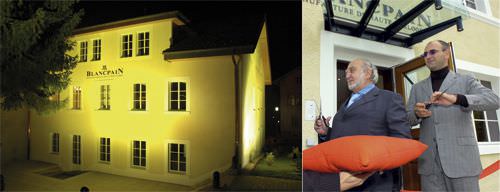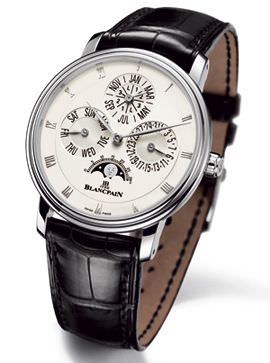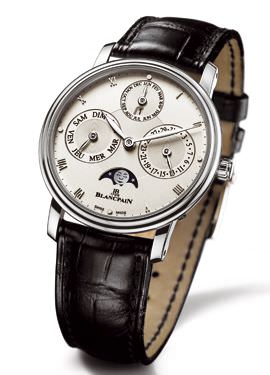
The renovated ‘Farm’, Nicolas G. Hayek and Marc A. Hayek
It was also the occasion for Marc A. Hayek, President Blancpain (and grandson of Nicolas G. Hayek, "with whom I grew up and who, for me, is a father figure,” as he confided to us), to reiterate the ‘philosophy’ of the brand. “Blancpain is an innovator by tradition. Already one or two centuries ago, Blancpain was innovating. Innovation is part of our roots, and today, we want to demonstrate that the respect for tradition has nothing to do with being old-fashioned or out-of-date. The respect for tradition does not mean repeating oneself indefinitely, quite the contrary. It means innovating while respecting the soul that comprises us.”
Travelling exhibition
The exhibition, entitled “A Tradition of Innovation” was created to try and demonstrate this innovation. It will travel around the world, passing through Dubai, Taiwan, China, Hong Kong and the United States, among other places.
It is designed to showcase all the ‘firsts’ and all of the records established by Blancpain, beginning with the world’s first automatic wristwatch realized in 1926 by Blancpain for the English watchmaker John Harwood who had designed it. The exhibition also includes the famous Fifty Fathoms, the icon of divers’ watches, and moves right up in time to the ladies’ Perpetual Calendar, the flattest watch in the world, created in 2005.
Between these two dates, it is obvious that Blancpain has accumulated a surprising number of firsts, especially in the realm of great finesse. For example, it created the world’s smallest round mechanical movement, the Ladybird in 1956, whose movement measured 11.85 mm (today it is an automatic in the form of the Calibre 615 measuring 15.7 mm in diameter). It also introduced the world’s smallest lunar phases display in 1983, the world’s thinest column wheel automatic chronograph in 1987 (which even today remains unequalled, with a thickness of 5.5 mm), the world’s smallest minute repeater in 1987, the world’s thinest flyback chronograph in 1988, and the world’s thinest tourbillon in 1989 (with its eight days of power reserve and a thickness of 3.5 mm).
Blancpain has also gained renown in the realm of the grand complication, notably with its 1735, released in 1991. Even today, it remains one of the most complicated wristwatches in the world with a minute repeater, flyback chronograph, tourbillon, perpetual calendar, and lunar phases. In 1993, Blancpain again innovated ‘in the tradition’ by presenting the first minute repeater wristwatch with automatons, thus re-connecting with its tradition of erotic watches. Closer to today, we can cite the world’s first wristwatch with the “marchante” Time Equation that was launched in 2004, as well as the Perpetual Calendar with the correctors under the horns, introduced this year.
A renovated farm
The ‘farm’, renovated into magnificent and luminous ateliers where Blancpain’s main artisanal and complex productions take place, is expected to become emblematic of the ‘family’ spirit that intends to immortalize the enterprise and “renew our loyal attachment to the Vallée de Joux, and to the watch values that it represents,” says Hayek. “It fully demonstrates that tradition remains alive and well. Here, our watchmakers make their timepieces from A to Z, each one being respon-sible for a specific type of product.”
This renovation will, it seems, allow Blancpain to face new challenges. “We still have much to do in the domain of the feminine timepiece,” admits Marc A. Hayek. “This renovation does not mean that we are going to make more and more watches at any price. No. Our growth will be supported by our veritable watchmaking essence. We want to persist in the special spirit that guides us, and not merely give in to what is easy.”
For the time being, the 50 employees (including a large number of master watchmakers) in Le Brassus have two immediate goals: the introduction of the Calibre 5621, the all new ultra-thin ladies’ Perpetual Calendar, and the preparations for the launch, announced for Baselworld 2006, of a totally new movement that is “manufactured 100-percent in-house,” although Hayek refuses to say any more about its specifications.
A rendezvous not to be missed.

VILLERET PERPETUAL CALENDAR WITH CORRECTORS UNDER THE LUGS
Platinum watch (38.00 mm x 10.2 mm) equipped with a Caibre 5653A self-winding mechanical movement. Opaline dial, day, date and month indicators, leap-year cycle indicator, moon phases at 6 o’clock, sapphire crystal front and back, 100-hour power reserve, water-resistant to 30 metres. Limited Edition to 201 pieces.

VILLERET LADIES’ ULTRA SLIM PERPETUAL CALENDAR
18 carat white gold watch (34 mm x 6.76 mm) equipped with a Calibre 5621 hand-wound mechanical movement. Opaline dial, day, date and month indicators, moon phases at 6 o’clock, sapphire crystal front and back, 40-hour power reserve, water-resistant to 30 metres. Limited Edition to 20 pieces.
Source: December - January 2006 Issue
Click here to subscribe to Europa Star Magazine.





